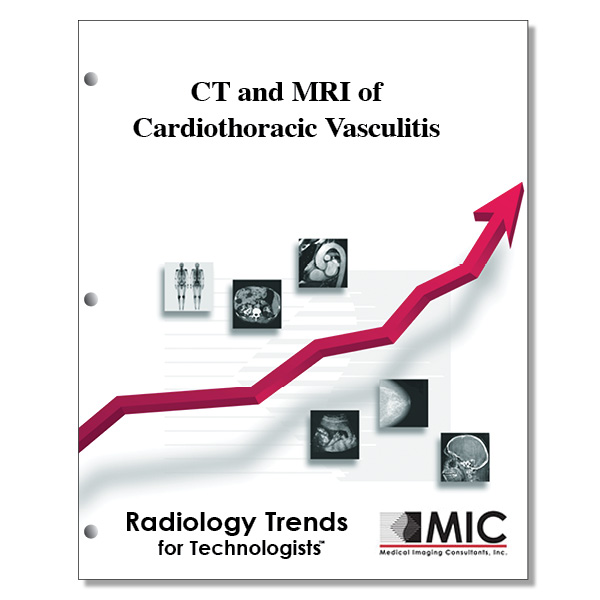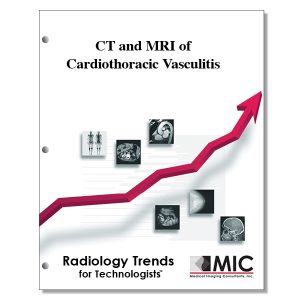

CT and MRI of Cardiothoracic Vasculitis
A review of the pathophysiologic, clinical, and imaging findings of vasculitis and other systemic diseases with a vasculitic component involving the heart.
Course ID: Q00566 Category: Radiology Trends for Technologists Modalities: Cardiac Interventional, CT, MRI, Vascular Interventional3.0 |
Satisfaction Guarantee |
$34.00
- Targeted CE
- Outline
- Objectives
Targeted CE per ARRT’s Discipline, Category, and Subcategory classification for enrollments starting after December 10, 2024:
[Note: Discipline-specific Targeted CE credits may be less than the total Category A credits approved for this course.]
Cardiac-Interventional Radiography: 3.00
Procedures: 3.00
Diagnostic and Electrophysiology Procedures: 1.50
Interventional Procedures: 1.50
Computed Tomography: 2.50
Procedures: 2.50
Neck and Chest: 2.50
Magnetic Resonance Imaging: 0.50
Procedures: 0.50
Body: 0.50
Registered Radiologist Assistant: 3.00
Procedures: 3.00
Thoracic Section: 2.50
Neurological, Vascular, and Lymphatic Sections: 0.50
Outline
- Introduction
- Imaging Modalities
- Spectrum of Cardiac Involvement
- Aorta and Great Vessels
- Pulmonary Hypertension
- Pericarditis
- Myocarditis
- Endocardial Involvement and Valvular Disease
- Coronary Involvement
- Epicardial Coronary Arteritis and Coronary Artery Encasement
- Microvascular Disease
- Detection of Fibrosis and Viability
- Vasculitis Involving the Heart
- Large Vessel Vasculitis
- Great Vessel Disease
- Valvular Disease
- Coronary Artery Disease
- Other Patterns of Disease
- Medium Vessel Vasculitis
- Polyarteritis Nodosa
- Kawasaki Disease
- Small Vessel Vasculitis
- Eosinophilic Granulomatosis with Polyangitis
- Granulomatosis with Polyangitis and Microscopic Polyangitis
- Cryoglobulinemic Vasculitis
- Variable Vessel Vasculitis
- Other Entities with a Vasculitic Component
- Rheumatoid Arthritis
- Systemic Lupus Erythematosus
- IgG4-related Disease
- Large Vessel Vasculitis
- Diagnostic Imaging Strategy
- Conclusion
Objectives
Upon completion of this course, students will:
- be familiar with conditions related to secondary vasculitis
- identify the diseases included in the large vessel vasculitis category
- be familiar with the complications associated with coronary vasculitis
- identify the advantages of cardiac CT when assessing the great vessels and coronary arteries
- be familiar with the global assessment of the cardiovascular system that cardiac MR offers
- understand the differences between MR angiography and CT angiography when detecting stenoses and aneurysms in patients with vasculitis
- be familiar with the MR imaging techniques employed to determine pulmonary transit time
- be familiar with Lake Louise Criteria for diagnosis of myocarditis
- identify the first-line modality for cardiac valvular assessment
- identify the best noninvasive technique for coronary artery evaluation
- be familiar with alternatives for assessing myocardial perfusion with cardiac MR
- be familiar with the main sources of errors in vasodilator stress cardiac MR imaging
- be familiar with the causes of coronary artery encasement
- be familiar with the population at greatest risk for giant cell arteritis
- identify the class Ia diagnosis standard for giant cell arteritis
- be familiar with the diagnostic criteria for Takayasu patients
- be familiar with the diagnostic criteria for giant cell arteritis
- identify the imaging modalities used for accurate gradations of aortic insufficiency
- be familiar with the similar findings in both Takayasu and giant cell arteritis
- identify the leading cause of mortality in patients suffering with Takayasu arteritis
- be familiar with the recommended therapeutic options for treating patients with larger vessel vasculitis
- identify the two main medium vessel vasculitides involving the heart
- identify the virus associated with poly arteritis nodosa vasculities
- be familiar with the diagnostic criteria for polyarteritis nodosa
- be familiar with the population most affected by Kawasaki disease
- be familiar with the diagnostic criteria for Kawasaki disease
- be familiar with the percentage of Kawasaki patients suffering from myocarditis
- identify the risks for developing coronary artery aneurysms in patients with Kawasaki disease
- identify the first-choice imaging modality for the assessment of cardiac involvement in patients with Kawasaki disease
- be familiar with the small vessel vasculitides
- identify the small vessel diseases that are included ANCA-associated vasculitis
- be familiar with the factors increasing cardiovascular risks associated with small vessel diseases
- be familiar with the indicators for eosinophilic granulomatosis with polyangitis
- be familiar with the most common pattern of cardiac involvement of patients with eosinophilic granulomatosis
- be familiar with the diagnostic criteria for eosinophilic granulomatosis
- be familiar with the cardiac involvement associated with granulomatosis with polyangitis
- identify the types of cryoglobulinemic vasculitis frequently associated with rheumatoid factor
- identify the diseases in the category of variable vessel vasculitis
- be familiar with the minor diagnostic criteria for cryoglobulinemic vasculitis
- be familiar with the cardiac manifestations of rheumatoid arthritis
